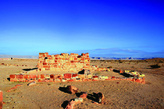Letter H
141. Ḥumayma | الحُميمة
al-‘Aqaba Governorate
Jāmi‘
JADIS no. 1892008
MEGA no. 37594
Coordinates: 29°56'58.6"N 35°20'46.0"E
29.949611, 35.346111
Letter H
al-‘Aqaba Governorate
Jāmi‘
JADIS no. 1892008
MEGA no. 37594
Coordinates: 29°56'58.6"N 35°20'46.0"E
29.949611, 35.346111
Plan: „rhomboidal“ (Antun 2016) or long rectangular with projecting miḥrāb at the S wall and an entrance in axial alignment in the N wall. The footing and the transversal arch belongs to phase II but they reflect the older layout of the Umayyad mosque I which is preserved only in the three lowest masonry courses. The mosque I building is flanked on both long sides by each one almost square courtyard without recognizable entrances, abutting the walls of the Umayyad mosque 1 but bedded a half a course higher. Therefore, these square spaces are interpreted by the excavators as later additions. The clearance of Mosque 1 revealed the presence of a smaller mosque (II) to the southwest, which shares the S wall of the W square space as its N wall. The W, E and S wall of Mosque 2 are preserved only up to one course. The E wall of mosque II abuts the outside wall of the miḥrāb of mosque I and points to a slightly later date.
Measurements: unknown.
Exterior: unknown.
Interior: unknown.
Building Materials: reddish to ocher colored sandstone blocks, coarsely cut, laid in horizontal rows, bond with lime mortar.
Construction details: semi-dressed massive cubic blocks in horizontal courses in the three lowest layers (Phase I of Mosque 1) with little use of lime mortar. The masonry sitting above phase I is random with the extensive use of mortar and interior wall plaster. The walls of mosque 2 are constructed by exterior and interior faces of wedge shaped massive stone blocks with a rubble-mortar-fill between the two faces.
Preservation: Ruined, mosque 1 phase II abandoned, not in use for Muslim prayer.
Inscription(s): none known.
Date(s): The pottery found in mosque 1 suggests for phase I a date to the late 7th or earlier 8th centuries AD, i. e. later Umayyad period. This mosque 1 has been rebuilt during the earlier 20th century AD. Mosque 2 has either served as an open-air desert type of prayer space (muṣallā) simultaneously with mosque 1, or it has been built when mosque 1 had been abandoned in the later Umayyad period. Since Ḥumayma played a crucial role in the ‘Abbasid revolt of AD 750, it seems possible that it was constructed at that time.
Traveler Reports: none known.
Bibliography: Oleson et alii 1993, 461-502; Oleson et alii 1995, 371- 354; Oleson et alii 1999, 411-450; Genequand 2002, 587-588 fig. 6,3; O’Kane 2005, 192-193 figs. 3, 6 and 3, 9; Schick 2007, 345–355; Bianchi 2007, 196 fig. 114; Nahar 2009, 65-68; Foote 2007, 457–465; Hattab 2015, 149-150; Shqour 2015, 117-122; Antun 2016, 105; Shqour 2019, 113-117; Samma - Tabbah 2019; Schick 2020 , no. 46.




